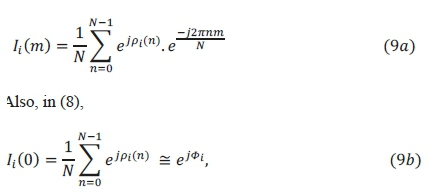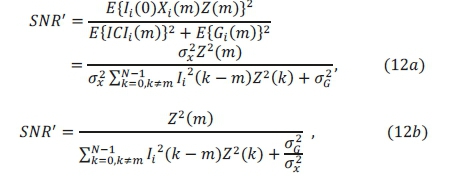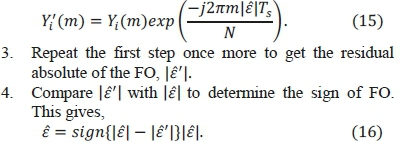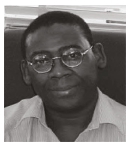Serviços Personalizados
Artigo
Indicadores
Links relacionados
-
 Citado por Google
Citado por Google -
 Similares em Google
Similares em Google
Compartilhar
SAIEE Africa Research Journal
versão On-line ISSN 1991-1696
versão impressa ISSN 0038-2221
SAIEE ARJ vol.110 no.4 Observatory, Johannesburg Dez. 2019
ARTICLES
Simplified ML-Based Carrier Frequency Offset and Phase Noise Estimation for CO-OFDM Systems
Muyiwa B. BalogunI; Olutayo O. OyerindeII; Fambirai TakawiraIII
IGraduate Member, IEEE
IISenior Member, IEEE
IIIMember, IEEE
ABSTRACT
The coherent optical orthogonal frequency division multiplexing (CO-OFDM) has become prominent among emerging telecommunication techniques and applications. However, carrier frequency offset (CFO) and laser phase noise adversely impact and degrade the performance of the CO-OFDM systems. In this paper, a simplified maximum-likelihood (ML) approach, which eliminates the need for the exhaustive search associated with traditional ML methods, is derived and utilized for the estimation of CFO and laser phase noise in CO-OFDM systems. Furthermore, to obtain an improved performance, the proposed simplified low-complexity ML estimator is uniquely combined with an efficient data-dependent pilot-aided (DD-PA) technique, for the acquisition of both the CFO and the laser phase noise. The performance of the simplified ML-based estimators is compared with existing methods and verified in a 16-ary quadrature amplitude modulation (16-QAM) CO-OFDM system with polarization mode dispersion (PMD), chromatic dispersion (CD) and other polarization dependent losses (PDLs) along the fiber link.
Index Terms: CO-OFDM, OFDM, Phase noise, Carrier Frequency Offset, Maximum Likelihood.
I. Introduction
The optical transport network has become an integral part of the revolutionary growth and demand for high-speed data transmission. Recent studies have focused largely on ways to effectively utilize the available bandwidth, which existing optical transport networks have to offer. The coherent optical orthogonal frequency division multiplexing (CO-OFDM) has become prominent among the other proposed techniques due to its high spectral efficiency and robustness against dispersions along the fiber link [1]-[6]. The CO-OFDM scheme however, is highly susceptible to phase noise and carrier frequency offset errors [4]-[7]. Various techniques and algorithms have been proposed to separately combat the degrading impact of these distortions in the optical transport network [7]-[13]. In [7, 8], pilot techniques were utilized for phase estimation in CO-OFDM systems.
Also, an Mth-power law data-aided estimator was implemented in [7]. However, the overall performance of this approach is grossly affected by the phase ambiguity associated with the Mth-power law method. The RF method was presented for phase noise estimation and compensation in [11]. In the RF estimation approach, the phase acquisition is realized by placing an RF-pilot tone in the middle of the OFDM transmit spectrum, which is then utilized at the receiver end to reverse any phase noise impairments in the system. Also, [14, 15] present a joint RF-based frequency offset and phase noise compensation scheme, in which the frequency offset is split into the integral part, known as the integral frequency offset (IFO) and the fractional part, known as the fractional frequency offset (FFO). During implementation, the IFO was estimated based on the pre-acquisition of the FFO. In the approach, the signal discrete spectrum is acquired by performing the fast Fourier transforms (FFT) on the received samples. The discrete spectrum is reshaped based on the frequency distribution properties of the FFT and the frequency offset is estimated by obtaining an index of the sample that has the maximum intensity value. In [13, 16], an FFT-based frequency estimation technique was proposed. The technique was implemented by first obtaining the estimated absolute value of the frequency offset by identifying the frequency of peak value in the signal spectrum. The sign of the frequency offset is then obtained using a piecewise linear function of the absolute value of the estimated frequency offset as the judging threshold [16]. In [12], the maximum likelihood (ML) scheme was utilized to estimate the channel and the phase noise. Also, [17] and [18] implemented a joint carrier frequency offset (CFO) and sampling frequency offset (SFO) ML scheme where two long training symbols were utilized for the entire estimation in the wireless domain. However, for the estimation of CFO and phase noise, the CFO can be assumed to vary slowly, therefore will remain constant across a frame, but the evolution of the phase noise within a frame results in fast variation and pilot subcarriers are required for efficient estimation. This paper therefore proposes the acquisition of both the CFO and the laser phase noise using a closed-form ML-based (CML) estimator, with a cost function that includes the effect of the dominance of the amplified spontaneous emission (ASE) noise along the optical fiber link. The major drawback of the traditional ML estimators is the associated computational burden, which is undesirable for practical and efficient implementation in OFDM-based optical systems.
However, solving and obtaining the CFO in a closed-form removes the need for exhaustive search and drastically reduces the computational burden associated with traditional ML algorithms [17]-[21]. Thus, two CML-based methods are proposed. First, a closed-form ML (CML) algorithm, with low complexity, is derived and utilized to acquire both the laser phase noise and the CFO in a CO-OFDM system. In the second approach, the derived CML estimator is combined with a data-dependent pilot-aided (DD-PA) technique, for the acquisition of the CFO and the laser phase noise. The data-dependent pilot-aided technique differs from the conventional pilot aided method where pilot subcarriers are predetermined. This approach is implemented in such a way that the phases of the pilot subcarriers are dependent and correlated to the phase of the data subcarriers. The hybrid technique is aimed at improving the overall system performance and efficiency, without the additional overhead that is associated with conventional pilot-aided methods [8].
The proposed schemes are modeled and implemented in a practical optical system stressed by polarization mode dispersion (PMD), chromatic dispersion (CD) and other polarization dependent losses (PDLs). Although PMD may only have a moderate impact on a high-speed optical system, the combined impact of PMD, CD, and PDL cannot be entirely ignored in the channel model of a practical optical system. Recently, the PDL has been shown to have a non-negligible impact on the optical fiber link [22]. Therefore, this work considers all these parameters during modeling before the subsequent derivation and implementation of the joint acquisition schemes.
The rest of this paper is organized as follows. Section II presents the CO-OFDM system model. The CO-OFDM system employed is modeled in the presence of the CFO, the laser phase noise and other pertinent fiber link distortions. Section III discusses the existing estimation techniques in the literature. In Section IV, the proposed simplified ML-based estimator for the acquisition of the CFO and laser phase noise in CO-OFDM systems, is derived, analyzed and discussed. Section V presents the simulation results for the proposed estimators. In Section VI, the associated computational complexity, in comparison with existing methods is discussed. Finally, Section VII gives the conclusion.
II. The System Model
As shown in the transceiver block diagram in Fig. 1, the binary inputs to the RF-OFDM transmitter are first encoded, and serial-to-parallel converted. The serial-to-parallel converted data are mapped and converted into time domain signals by the IFFT operation. The resulting signals are digital-to-analog converted and then undergo the filtering process, using the low pass filter to address aliasing. The RF-to-optical up-converter block transforms the transmit signal from the electrical domain to the optical domain using an optical in-phase/quadrature (IQ) modulator, which consists of two Mach-Zehnder modulators (MZMs) with a 90 degree phase offset [6]. Also, Fig. 1b shows the frame structure for the proposed CFO and phase noise estimation. The baseband transmitted OFDM signal after inverse FFT (IFFT) is given as [6]:


where xi(n) represents the nthsample of the ithOFDM symbol, Ν is the total number of subcarriers, Μ is the number of used subcarriers and Xi(m) represents the data symbol transmitted on the mthdata subcarrier. The received signal after passing through the optical channel can be written as:

where ε, ® and C_1(.) represent the normalized CFO, the circular convolution and IDFT respectively, while gi(n) is the total ASE noise generated from inline optical amplifiers. The connotation Z(m), which is the holistic channel impulse response of the fiber link encompassing the polarization mode dispersion, and other polarization dependent losses, is expressed in the frequency domain as [6]:

where the number of the PMD/PDL cascading elements in the entire fiber link is denoted as L, with each section represented by its birefringence vector  and PDL vector "
and PDL vector " as detailed in [6]. Also, the term μ represents the Pauli's vector, while
as detailed in [6]. Also, the term μ represents the Pauli's vector, while
quadratic dependence on frequency is assumed. The epresentation 0(m) is the group velocity dispersion (GVD), vhich is primarily a phase shift due to distortion in the fiber link and is expressed mathematically as:

vhere denotes the chromatic dispersion in the link, fmis he frequency for the mthsubcarrier while f0 is the center optical frequency. The laser phase noise Pi(ri) is modeled as a Weiner-Levy process, which can be expressed as [10]:

vhere d(v) denotes the independently incremental movement of the phase noise at time instant v and can be described as Gaussian distributed with zero mean and variance σ2= lnhTs, where h is the combined laser linewidth, Tsis the symbol period and NCPis the cyclic prefix (CP) length. The expression in (2) can be rewritten as:

The FFT is performed to recover the received OFDM nformation symbol, which is given as [17, 23]:

Where lCli(m) is tC is a andom variable as detailed in [10], Ii(m) is a function of the distortion due to the laser phase noise, which can be expressed as:

and it denotes the phase evolution, which corresponds to the ime-average of the laser phase noise over the ithOFDM symbol and Φίis considered as the common phase error (CPE) given as [12]:

Thus (8) becomes

where

Also, the effective signal-noise-ratio (SNR') is expressed as [15]:

where  is the variance of the transmitted information signal and
is the variance of the transmitted information signal and  is the variance of the ASE noise, while
is the variance of the ASE noise, while  is the original channel SNR without the effect of ICIi(m). The SNR is related to the optical SNR (OSNR) by the expression [5]
is the original channel SNR without the effect of ICIi(m). The SNR is related to the optical SNR (OSNR) by the expression [5]

where Bf is the central bandwidth while Rsis the symbol rate [5].
From the above expressions, the received signal can be analyzed and the impact of the phase noise as well as the CFO can be estimated, evaluated and compensated.
III. Existing Estimation Techniques
In the optical domain, the prominent schemes among the methods utilized for CFO and phase noise estimation, as related to this work, are reviewed. In [13, 16], an FFT-based algorithm was proposed for frequency offset estimation in CO-OFDM systems. The algorithm has been utilized earlier in [16] but with more computational burden. The FFT-based algorithm in [13] therefore implements the algorithm with an improved computational complexity. In the paper, only the frequency offset (FO) error was considered for estimation, while the phase noise error was neglected. Also, the impact of chromatic dispersion as well as the influence of polarization mode dispersion was not put into consideration. Considering (11) in the absence of phase noise, the FFT-based frequency offset algorithm as proposed in [16] is designed as follows:


In [11], the RF-pilot based estimation method is proposed. The RF-based method is implemented in such a way that the CFO can be easily estimated by searching the peak of the spectral samples. The system model employed was also simplistic, without considering fiber dispersions and attenuations. The pilot scheme utilized introduces some overhead into the system.
Joint carrier frequency offset and phase noise using RF-based technique is detailed in [14]. In order to obtain the optimum compensation performance with low computing cost when combining the RF-phase estimation and RF-frequency offset estimation, the joint compensation scheme is developed in such a way that the only integral part frequency offset (IFO), needs to be estimated by the RF-frequency offset estimates based on the aid of the pre-estimation of the fractional frequency offset (FFO). After that, RF-phase estimation utilizes a band-rejection filter (BRF) filter and compensates all the phase impairments. Three computational steps are taken into consideration according to [14]:
1. The signal discrete spectrum is obtained by performing FFT on N received samples. The intensity of signal discrete spectrum can thus be formulated as

2. In order to observe spectral shift and estimate FO conveniently, the discrete spectrum is reshaped based on the frequency distribution characteristics of the FFT.
3. The FO can therefore be estimated by finding an index of the sample that has the maximum intensity value, i.e.

where ε denotes the estimated FO value, V/Cm) stands for the discrete spectral samples after reshaping, find max(A) represents the operation of "finding the index number corresponding to the maximum value of A" and fsc represents the spectral resolution.
In order to avoid unnecessary repeat operations for phase compensation, the estimated FO value ε is directly set as the central frequency for the BPF instead of employing a low pass filter (LPF) to filter the RF-pilot after IFO correction. In this case, the extracted RF-pilot will include all the phase impairments, which are induced not only by the laser phase noise, but the IFO as well as residual FFO. The combined phase impairments can be calculated as [14]:

where abs(.) represents the absolute value of the input element, y'BPFis the filtered signal (namely the extracted RF-pilot), ρ (η) and i9j(n) represent the estimated phase noise of laser linewidth and ASE induced phase error respectively. In [12], a maximum likelihood (ML) phase estimation and channel estimation for CO-OFDM was proposed. The focus was on phase estimation and channel estimation, while the frequency offset error was not considered. The use of ML for joint phase and frequency estimation was also not considered. The system model employed does not consider the holistic fiber dispersion and distortions like the polarization mode dispersion as well as the chromatic dispersion in the system. The proposed algorithm is however, a hybrid method as it combines ML with pilot-assisted method for optimal performance. Assuming perfect frequency synchronization and FFT window, the received signal is can be described as:

Also, it is assumed that the channel transfer function and the noise variance Sm2of the combined noise interference Wt (m) are known.
Thus, the search for the optimal phase Φ; becomes an ML problem, that is, the minimization of the following likelihood function given by [12]:

where Np represents the number of pilot subcarriers. In (21), the expression can be expanded as

Therefore, by expanding (21), the minimization of Atwith respect to the common phase noise Φ; results in [12]:

Following the same approach as in (21)-(23), the ML channel estimate is obtained according to [12] by:

In (24), it is assumed the phase noise has been obtained from (23). If the effect of noise variance Sm2is ignored, (23) will reduce to the least square (LS) method. The ML method may
be preferred over LS method in optical OFDM systems. In wireless system, the noise is dominated by the detection circuit thermal noise, which can be assumed constant across all subcarriers. However, in the optical system, the dominant noise is the amplified-spontaneous noise distributed along many fiber spans. Due to the interaction of PMD and PDL, the noise for individual carriers can be different or 'colored'. Therefore, it is advantageous to use the ML method that includes the effect of the colored noise variance [12]. As seen from this ML approach, the same procedure can also be assumed in the case of the acquisition of both the CFO and the phase noise in CO-OFDM systems.
IV. The Proposed Ml-Based Estimation Algorithms
This section presents the proposed ML-based estimation methods for the CFO and the phase noise. For the estimation of the phase noise, the following are defined. Set Mp = of pilot tones to be available at each
of pilot tones to be available at each
payload OFDM symbol for phase estimation. The CFO is assumed to vary slowly, therefore remains constant across each frame, while the phase is estimated at each frame based on available pilot subcarriers.
Hence, from (11), the following expression is obtained:

In order to obtain the estimate of the CFO ε, the received sequence is considered, in the absence of noise-interference and taking eJ*' «1. Thus, in the frequency domain, using the pilot structure as described in Fig. 1b, which shows the pilot position for the CFO estimation, i.e. mCf0,

Assuming an OFDM symbol is repeated, the two consecutive sequences are the same except for a phase difference, i.e. [24]

Now including the noise-interference component, then

Thus, to obtain the CFO ε, the probability density function  is expressed as:
is expressed as:

And the ML estimate for CFO ε is obtained as

where

The CFO ε can be obtained in a closed-form to avoid the exhaustive ML search. Also, the variance  is included due to the dominance of the ASE noise along the optical fiber link, which cannot be ignored. The expression in (32) can be expanded and re-written as:
is included due to the dominance of the ASE noise along the optical fiber link, which cannot be ignored. The expression in (32) can be expanded and re-written as:

where C is independent of the CFO ε. Since ε affects only the phase of the expression on the right side of (33) and not its absolute value, then the maximum of Γ (ε) is achieved when its phase is zero. Thus,

Then the CFO ε is obtained in a closed-form as:

Now for the estimation of the phase noise, considering (25) with no CFO, having obtained the estimate ε and assuming a perfect compensation, an ML cost function is defined based on (25), which is expressed as

The expression in (36) can be expanded and re-written as

Hence, the ML estimate for Φ; is obtained by

Hence, the range of the CPE can be searched across Νφcandidate values with step size αφ ,  , to acquire the
, to acquire the
estimate  i. As obtained in (35), Φιcan also be obtained in a closed-form, which is expressed as
i. As obtained in (35), Φιcan also be obtained in a closed-form, which is expressed as

Thus, the exhaustive search is no longer required, which drastically reduces the computational burden and the overall complexity of the system.
Furthermore, instead of utilizing the CPE ML estimator derived in (39), an efficient data-dependent pilot-aided (DD-PA) technique is implemented for the laser phase acquisition while still utilizing the derived ML scheme in (35) for CFO estimation. This approach differs from the conventional pilot aided method where pilot subcarriers are predetermined. In this method, the phases of the pilot subcarriers are selected in a way that their average phase angle is direct opposite of the data carrying subcarriers. This is ensured by the condition expressed below

where  is the averaging operation and arg(.) denotes the phase angle.
is the averaging operation and arg(.) denotes the phase angle.
Thus, the average phase angle of the pilot subcarriers is selected by satisfying the condition stated above, where  . The CPE
. The CPE
is therefore obtained by adding the phases of the Mppilot subcarriers and the corresponding data carrying subcarriers as expressed below

The pilot subcarriers are all positioned equally in the OFDM frame to avoid any arbitrariness. Also, by using the expression in (41), the CPE is estimated without prior information on the phase of the pilot subcarriers.
V. Simulations And Discussion
This section investigates and analyses the effectiveness of the proposed ML-based algorithms and implemented in a CO-OFDM system. We consider a 20 Gb/s CO-OFDM system, with FFT size 256 and a central wavelength of 1550nm while a 12.5% cyclic prefix is used. The 16-QAM-modulation format is used while the sampling duration of the OFDM symbol is 28.8ns. The optical system model is implemented in a practical scenario with prevailing fiber-link dispersion including PDLs, whose effects on optical links are detailed in [22]. The fiber link is 100 km span distance standard single mode fiber (SSMF) with fiber dispersion 17 ps/km/nm, loss coefficient of 0.2 dB/km, and differential group delay of 5 ps/yfkm. The EDFA has 16 dB gain with noise figure of 4 dB and the non-linear coefficient of the fiber is 1.32/W/ km.
In Fig. 2, the mean square error (MSE) plots of the proposed closed-form ML (CML) based schemes are compared with the existing ML scheme [12], where the MSEs of the normalized CFO ε, and the CPE Φι, are defined as and
and  respectively.
respectively.

The CML/CML scheme utilizes the closed-form ML technique as derived in (35) and (39), for the acquisition of both the CFO and laser phase noise respectively. The laser phase noise estimation is performed using five pilot symbols to account for the variation within the frame. Also, the CML/DD-PA scheme employs the DD-PA technique for the estimation of the laser phase noise, followed by the closed-form ML acquisition of the CFO. The plots show the performance of the CML/CML scheme, the CML/DD-PA scheme as well as the existing ML scheme [12]. The laser linewidth is set to 160 KHz while the impact of the proposed schemes verified at different values of CFO (i.e. CFO = 0.10, 0.25). The MSE plots clearly show that the use of the proposed CML-based schemes offers a better performance in comparison to the existing ML technique. The CML-based schemes employ five pilots, which are evenly distributed. The number of pilots utilized, helps to improve system performance but at a cost of an increased overhead and reduced bandwidth efficiency. Also, the use of the CML scheme combined with the DD-PA phase acquisition technique (CML/DD-PA) ensures an improved estimation and overall system performance. The graph in Fig. 3 also shows the impact of the estimation algorithm with different phase noise values of linewidth 400 KHz and 800 KHz, while the CFO is set to ε = 0.10. As seen from the plots, the proposed methods outperform the existing ML technique. It is noteworthy that despite the proposed schemes both utilizes the derived CML algorithm for the acquisition of the CFO, the effectiveness of the technique employed for the first stage estimation of the laser phase noise essentially impacts the overall performance and efficiency of the estimation schemes. In Fig. 4, the BER performance of the proposed CML-based schemes is compared with an RF-based joint estimator [14] and an FFT-based acquisition scheme. The joint estimation scheme in [14] implements an RF-pilot aided phase recovery and frequency estimation method for the acquisition of both the laser phase noise and the CFO. The RF-based scheme is compared with the proposed CML-based schemes by utilizing a RF-pilot tone with 6.3% of power overhead, which is inserted in the center of the OFDM band. A band pass filter with 100MHz bandwidth is applied to filter out the RF-pilot tone at the receiver. Also, the plot shows the implementation of an FFT-based scheme. Before the acquisition of the CFO using the FFT method, the laser phase noise is estimated using a conventional pilot-based method [9]. The impact of the CFO, which is set at ε0.1 is shown as well as the perfect scenario where CFO ε = 0, to enable a clear comparison of the impact of the CML-based schemes on the CO-OFDM system model used. The combined laser linewidth h is set to 160 KHz. The plots show that our proposed schemes outperform the existing ML scheme as well as the FFT-based method. Furthermore from the plots, the RF-based joint scheme outperforms the CML/CML scheme. However, the CML/DD-PA scheme, where the DD-PA technique is utilized for the acquisition of the phase noise before using the CML algorithm to obtain the CFO, offers a slightly better system performance as compared to the RF-based technique. Also for comparison, the CML technique is combined with an RF-pilot phase estimator (SML/RFP). The CML/RFP offers aperformance close to both the CML/DD-PA and the RF-based joint schemes. However, the RF-pilot tone in the CML/RFP as well as the RF-based joint schemes in [14], is grossly impacted by the size of the frequency guard band around the DC subcarrier, while the effectiveness degrades further under ASE and other fiber nonlinearity related impairments. In Fig. 5 shows the MSE versus OSNR plot of the impact of fiber impairments on the overall performance of the CML/DD-PA and the RF-based joint estimation schemes. In the scenario where the fiber link is assumed compensated with no influence of fiber dispersions, the RF-based joint scheme tends to outperform the CML/DD-PA scheme. However, at CD of 1700 ps/nm, the CML/DD-PA shows better robustness against dispersion as compared to the RF-based scheme. Although the performance of both the CML/DD-PA scheme and the RF-based scheme steadily degrades as the CD is further increased, the CML/DD-PA offers a superior overall performance in the presence of fiber dispersions. In Fig. 6, the MSE plots of the proposed joint estimation schemes in comparison with existing methods are shown. From the plot, the CML schemes outperform both the FFT-based estimator and the ML scheme in [12]. Also, the CML/DD-PA scheme still offers an enhanced performance than the RF-based scheme and offers better efficiency as mentioned earlier. Fig. 7 shows the MSEs of the estimation schemes as a function of the CFO at OSNR = 15 dB. The plots verify the performance of the proposed schemes in comparison with the existing schemes. Also, the RF-based joint estimator closely approaches but slightly outperformed by the CML/DD-PA technique. As a result of the BPF, the complexity of the RF-pilot scheme is significantly higher as compared to the proposed schemes. Thus, the CML/DD-PA offers an overall better performance and efficiency.





VI. Computational Complexity
The complexity of the ML method proposed in [12] requires the traditional search similar to the method in [21]. By referring to (38), evaluating the sequence Cj(mp) = Yi(mp)Xi*(mp)Z*(mp) requires NMpcomplex multiplications. The curly bracket in the expression XmpSMp ^{Cj(mp)e"J*i} in (38) also requires NMp complex multiplications, N(Mp -1) complex additions while the required exhaustive search is over N candidate values. Thus, the overall complexity of the estimator in (38) is of the order 0(N2Mp). Deriving the closed-form expression as in (39), the estimator requires NMp complex multiplications N(Mp - 1) complex additions while the need for the exhaustive search is eliminated. Hence, the complexity of (39) is of the order O(N) as the search operation is avoided. This shows that the closed-form expression, which enables the avoidance of the traditional ML search, offers a considerably lower complexity as compared to existing ML scheme. The complexity of the algorithms in terms of complex multiplications and complex additions is presented in Table I.

VII. Conclusion
A simplified ML-based scheme has been proposed and implemented for the joint acquisition of the laser phase noise and the CFO in an all-encompassing optical system model with an uncompensated fiber-link. Existing ML algorithms, which has been said to exhibit better tolerance towards distortion in optical systems, comes with a high computational burdens. Thus, a simplified ML estimator, with low complexity, has been adapted, derived and implemented in the optical domain. First, the CML scheme is implemented, where the simplified ML estimator is utilized to acquire both the laser phase noise and the CFO. The second scheme (CML/DD-PA) employed a DD-PA technique for the estimation of the laser phase noise followed by the CML estimator for the acquisition of the CFO. Simulation results show that the proposed closed-form ML-based acquisition schemes perform comprehensively well. However, the CML/DD-PA scheme offers a better overall system performance compared to the first scheme, where the CML estimator is employed for the estimation of both the laser phase noise and the CFO. In the presence of impairments along the fiber link, the CML/DD-PA approach exhibit a balanced, low-complexity and better performance over the existing RF-pilot based method. Also it is noteworthy that the effectiveness of the technique employed for the laser phase noise estimation impacts the overall performance of the proposed closed-form ML-based joint acquisition schemes.
References
[1] W. Shieh, and C. Athaudage, "Coherent optical orthogonal frequency division multiplexing," Electron Lett., vol. 42, pp. 587-589, 2006. [ Links ]
[2] A. Barbieri, G. Colavolpe, T. Foggi, E. Forestieri and G. Prati, "OFDM vs. single-carrier transmission for 100 Gbps optical communication," Journal of Lightwave Technol., vol. 28, no. 17, pp. 2537-2551, 2010. [ Links ]
[3] E. Ip, A.P.T. Lau, D.J.F. Barros and J.M. Kahn, "Coherent detection in optical fiber systems," Opt. Express, vol. 16, pp. 753-791, 2008. [ Links ]
[4] I.B. Djordjevic and B. Vasic, "Orthogonal frequency division multiplexing for high-speed optical transmission," Opt. Express, vol. 14, pp. 3767-3775, 2006. [ Links ]
[5] D. Ives, B. Thomsen, R. Maher and S. Savory, "Estimating OSNR of equalized QPSK signals," Opt. Express, vol. 19, no. 26, pp. 661-667, 2011 [ Links ]
[6] W. Shieh and I. Djordjevic, "OFDM for optical communications," Academic Press, 2010.
[7] X. Yi, W. Shieh, and Y. Tang, "Phase estimation for coherent optical OFDM," IEEE Photonics Technol. Lett, vol. 19, no. 12, pp. 919-921, 2007. [ Links ]
[8] S. T. Le, T. Kanesan, E. Giacoumidis, N.J. Doran, and A.D. Ellis, "Quasi-pilot aided phase noise estimation for coherent optical OFDM systems," IEEE Photonics Technol. Lett., vol. 26, no. 5, pp. 504-507, 2014. [ Links ]
[9] S. Cao, C. Yu, and P. Y. Kam, "Decision-aided, pilot-aided, decision-feedback phase estimation for coherent optical OFDM systems," IEEE Photonics Technol. Lett., vol. 24, no. 22, pp. 2067-2069, 2012. [ Links ]
[10] S. T. Le, P. A. Haigh, A. D. Ellis and S. K. Turitsyn, "Blind Phase Noise Estimation for CO-OFDM Transmissions," in Journal of Lightwave Technol., vol. 34, no. 2, pp. 745-753, 2016. [ Links ]
[11] S. Randel, S. Adhikari, and S. L. Jansen, "Analysis of RF-pilot-based phase noise compensation for coherent optical OFDM systems," IEEE Photonics Technol. Lett., vol. 22, no. 17, pp. 1288-1290, 2010. [ Links ]
[12] W. Shieh, "Maximum-likelihood phase and channel estimation for coherent optical OFDM," IEEE Photonics Technol. Lett., vol. 20, no. 8, pp. 605-607, 2008. [ Links ]
[13] S. Yu, Y. Cao, H. Leng, G. Wu, and W. Gu, "Frequency estimation for optical coherent M-QAM system without removing modulated data phase," Opt. Commun., vol. 285, no. 18, pp. 3692-3696, Aug. 2012. [ Links ]
[14] X. Zhou, X. Yang, R. Li, and K. Long, "Efficient joint carrier frequency offset and phase noise compensation scheme for high-speed coherent optical OFDM systems," Journal of Lightwave Technol., vol. 31, no. 11, pp. 1755-1761, 2013. [ Links ]
[15] X. Zhou, K. P Long, R. Li, X. L. Yang, and Z. S. Zhang, "A simple and efficient frequency offset estimation algorithm for high-speed coherent optical OFDM systems," Opt. Exp, vol. 20, no. 7, pp. 7350-7361, Mar. 2012. [ Links ]
[16] Y. Liu, Y. Peng, S. Wang, and Z. Chen, "Improved FFT-based frequency offset estimation algorithm for coherent optical systems," IEEE Photonics Technol. Lett., vol. 26, no. 6, pp. 631-616, 2014. [ Links ]
[17] H. Nguyen-Le, T. Le-Ngoc, and C. C. Ko, "RLS-based joint estimation and tracking of channel response, sampling, and carrier frequency offsets for OFDM," IEEE Trans. Broadcast, vol. 55, pp. 84-94, Mar. 2009. [ Links ]
[18] X. Wang and B. Hu, "A low-complexity ML Estimator for carrier and Sampling Frequency Offsets in OFDM Systems," IEEE Commun. Lett., vol. 18, no. 3, pp. 503-506, Mar. 2014. [ Links ]
[19] J. J. Vande Beek, M. Sandell, and P. O .Borjesson, "ML estimation of time and frequency offset in OFDM systems," IEEE Trans. Signal processing, vol. 43, pp. 761-766, August 1997. [ Links ]
[20] T. M. Schmidl and D. C. Cox, "Robust frequency and timing synchronization for OFDM," IEEE Trans. Commun., vol. 45, pp. 16131621, December 1997. [ Links ]
[21] Y.-H. Kim and J.-H. Lee, "Joint maximum likelihood estimation of carrier and sampling frequency offsets for OFDM systems," IEEE Trans. Broadcast., vol. 57, pp. 277-283, June 2011. [ Links ]
[22] N. Rossi, P. Serena and A. Bononi, "Polarization-Dependent Loss Impact on Coherent Optical Systems in the Presence of Fiber Nonlinearity," IEEE Photonics Technol. Lett., vol. 26, pp. 334-337, Feb. 2014. [ Links ]
[23] M.B. Balogun, O.O. Oyerinde and F. Takawira, "Performance of ML-Based Carrier Frequency Offset Estimation in CO-OFDM Systems," in Proc. IEEE AFRICON Conf., pp. 175-180, Sept. 2017.
[24] P. H. Moose, "A technique for orthogonal frequency division multiplexing frequency offset correction," IEEE Trans. Commun., vol.42, pp. 2908-2914, October 1994.
This work was supported by Société Internationale de Telecommunications Aéronautiques (SITA), United Kingdom and the Center for Telecommunication Access and Services (CeTAS), School of Electrical and Information Engineering, University of the Witwatersrand.
M.B. Balogun, O.O. Oyerinde and F. Takawira are with the University of the Witwatersrand, Johannesburg, 2001, South Africa (email: muyiwa.balogun@wits.ac.za, olutayo.oyerinde@wits.ac.za, fambirai.takawira @wits.ac.za).

Muyiwa B. Balogun received the B.Sc. degree (Hons.) in Electrical Engineering from the university of Ilorin, Nigeria, in 2009, and the M.Sc. degree in Electronic Engineering from the university of KwaZulu-Natal (UKZN) in 2014. He is currently with the university of the Witwatersrand, SA as a Doctoral Researcher. His research interests include signal processing, frequency synchronization algorithms for multicarrier systems, phase noise estimation, orthogonal frequency-division multiplexing systems (OFDM), and optical transport networks.

Olutayo O. Oyerinde received the B.Sc. (Hons.) and M.Sc. degrees in electrical and electronic engineering from Obafemi Awolowo University, Ile-Ife, Nigeria, in 2000 and 2004, respectively, and the Ph.D. degree in electronic engineering from the School of Engineering, University of KwaZulu-Natal, South Africa, in 2010. He was a Post-Doctoral Research Fellow with the School of Engineering, UKZN, under UKZN Post-Doctoral Research Funding.
He is currently a Telecommunications Lecturer with the School of Electrical and Information Engineering, University of the Witwatersrand, South Africa. His research interests are in the area of wireless communications including multiple antenna systems, orthogonal frequency-division multiplexing system and channels estimation, and signal processing techniques.

Fambirai Takawira received the B.Sc. degree (Hons.) in Electrical and Electronic Engineering from The University of Manchester, Manchester, U.K., in 1981, and the Ph.D. degree from Cambridge University, Cambridge, U.K., in 1984. Prof. Takawira has held various academic positions, including the Head of the School of Electrical, Electronic, and Computer Engineering and, just before his departure, the Dean of the Faculty of Engineering at the University of KwaZulu-Natal (UKZN), Durban, South Africa. He has also held appointments at the University of Zimbabwe, Harare, Zimbabwe; the University of California at San Diego, La Jolla, CA, USA; British Telecom Research Laboratories; and the National University of Singapore, Singapore. After 19 years at UKZN, in 2012, he joined the University of the Witwatersrand, Johannesburg, South Africa. His research interests include wireless communication systems and networks.
Prof. Takawira has served on several conference-organizing committees. He served as the Communications Society Director for Europe, Middle East, and Africa region for the 2012-2013 term. He was an Editor of the IEEE Transactions on Wireless Communications.














